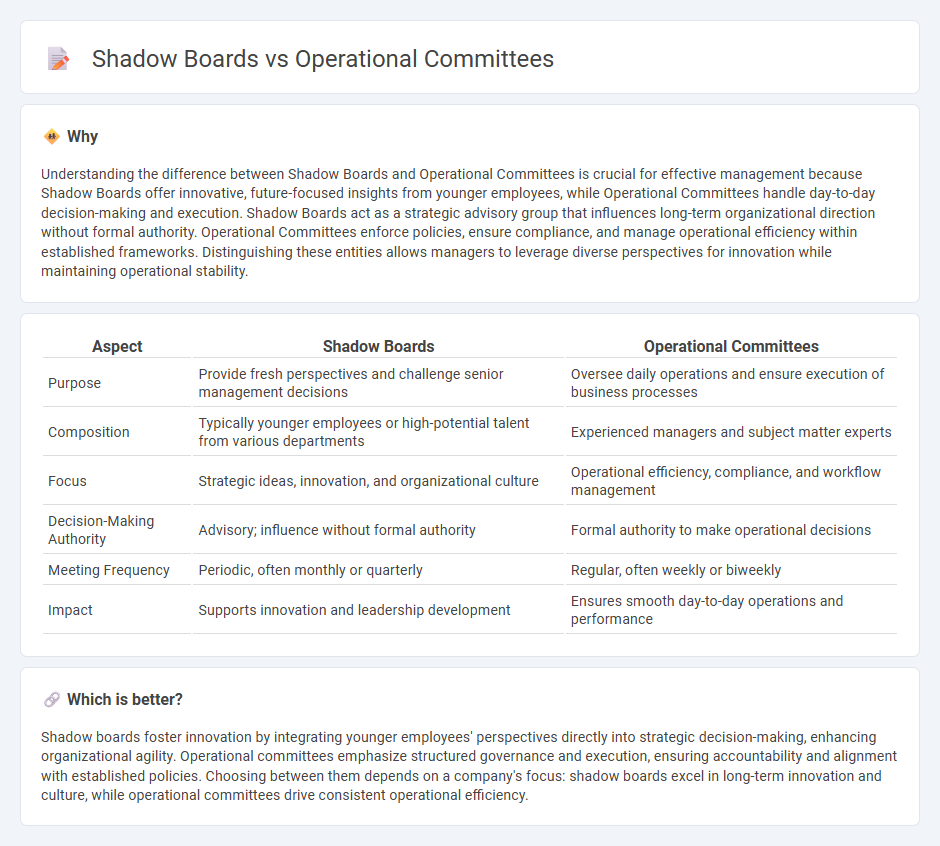
Shadow boards consist of emerging leaders who provide innovative insights and challenge traditional management practices, driving strategic decision-making from a fresh perspective. Operational committees focus on overseeing day-to-day functions, ensuring compliance, and executing established policies to maintain organizational efficiency. Explore the differences between shadow boards and operational committees to enhance your management strategies.
Why it is important
Understanding the difference between Shadow Boards and Operational Committees is crucial for effective management because Shadow Boards offer innovative, future-focused insights from younger employees, while Operational Committees handle day-to-day decision-making and execution. Shadow Boards act as a strategic advisory group that influences long-term organizational direction without formal authority. Operational Committees enforce policies, ensure compliance, and manage operational efficiency within established frameworks. Distinguishing these entities allows managers to leverage diverse perspectives for innovation while maintaining operational stability.
Comparison Table
| Aspect | Shadow Boards | Operational Committees |
|---|---|---|
| Purpose | Provide fresh perspectives and challenge senior management decisions | Oversee daily operations and ensure execution of business processes |
| Composition | Typically younger employees or high-potential talent from various departments | Experienced managers and subject matter experts |
| Focus | Strategic ideas, innovation, and organizational culture | Operational efficiency, compliance, and workflow management |
| Decision-Making Authority | Advisory; influence without formal authority | Formal authority to make operational decisions |
| Meeting Frequency | Periodic, often monthly or quarterly | Regular, often weekly or biweekly |
| Impact | Supports innovation and leadership development | Ensures smooth day-to-day operations and performance |
Which is better?
Shadow boards foster innovation by integrating younger employees' perspectives directly into strategic decision-making, enhancing organizational agility. Operational committees emphasize structured governance and execution, ensuring accountability and alignment with established policies. Choosing between them depends on a company's focus: shadow boards excel in long-term innovation and culture, while operational committees drive consistent operational efficiency.
Connection
Shadow boards consist of emerging leaders who provide fresh insights and challenge senior management decisions, while operational committees focus on executing strategic initiatives and overseeing daily business functions. Both structures enhance organizational agility by fostering collaborative decision-making and ensuring alignment between innovative ideas and operational execution. Integrating shadow boards with operational committees promotes transparent communication and drives continuous improvement across management layers.
Key Terms
Decision-making authority
Operational committees hold formal decision-making authority within organizations, executing strategic plans and managing daily operations based on delegated powers from senior management. Shadow boards act as advisory groups composed of younger or non-executive members who provide fresh perspectives and recommendations but lack official decision-making power. Discover how leveraging both structures can enhance corporate governance and innovation.
Strategic input
Operational committees concentrate on managing day-to-day activities and ensuring efficient execution of business processes, directly impacting organizational performance. Shadow boards consist of emerging leaders who provide fresh, strategic insights by acting as a sounding board for the executive team, fostering innovation and long-term vision. Explore the distinct roles of these groups to understand how they enhance strategic input and decision-making.
Organizational influence
Operational committees drive decision-making by involving key stakeholders and ensuring alignment with organizational goals, directly impacting business processes and outcomes. Shadow boards consist of younger or non-executive employees who provide fresh perspectives and challenge traditional leadership, fostering innovation and future-ready strategies. Explore the distinct roles and influence of both structures to enhance organizational effectiveness and governance.
Source and External Links
What is an Operating Committee? - This webpage provides an overview of operating committees, including their roles in overseeing day-to-day operations and guiding strategic decisions within a company.
Operating Committee Overview - This resource defines the operating committee as a group of senior executives responsible for overseeing day-to-day operations and strategic implementation in an organization.
Operations Committee Duties - This article discusses the duties of an operations committee, including overseeing operational functions from a strategic level and making policy decisions.
 dowidth.com
dowidth.com